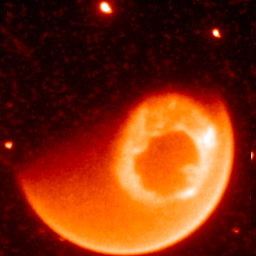Astronomy:Bastille Day event
 IMAGE ultraviolet image of the Aurora Borealis on 15 July 2000 | |
| Type | Geomagnetic storm |
|---|---|
| Formed | 14 July 2000 |
| Dissipated | 16 July 2000 |
| Damage | Minor satellite and terrestrial power transformer damage |
| Areas affected | Worldwide |
Part of Solar cycle 23 | |
The Bastille Day Event was a powerful solar storm on 14-16 July 2000. The flare occurred during the national day of France . The solar activity happened near the peak of the solar maximum of solar cycle 23.[1][2]
Overview
The flare
The X5.7-class flare originated from a sunspot region known as Active region 9077, which subsequently caused an S3 particle storm on Earth fifteen minutes later as energetic protons bombarded the ionosphere.[1][3] It was the strongest solar radiation event since 1989.[3] The proton event was four times more intense than any previously recorded since the launches of SOHO in 1995 and ACE in 1997.[1]
Geomagnetic storm
The flare was also followed by a full-halo coronal mass ejection (CME)[1] and a geomagnetic super storm on 15-16 July. The geomagnetic storm peaked at the extreme level, G5, in the late hours of 15 July, and registered a Dst of -301 nT, causing minor damage to power transformers and satellites[4] and was also one of only two solar storms having registered 9+ at Kp max since 1989, the other being the Halloween solar storms of 2003.[5][6]
Aftermath
Despite their great distance from the Sun, the Bastille Day event was observed by Voyager 1 and Voyager 2.[7]
Due to being the first major solar storm since the launch of various solar-monitoring satellites, the Bastille Day event proved important towards helping scientists piece together a general theory of how eruptions on the sun occur as well as protecting the Earth from a larger event, such as a Carrington-class event, some day in the future.[8]
See also
References
- ↑ 1.0 1.1 1.2 1.3 "Space Radiation Storm". NASA. 2004-07-14. https://science.nasa.gov/headlines/y2000/ast14jul_2m.htm. Retrieved 2007-03-09.
- ↑ "NASA Says Solar Flare Caused Radio Blackouts". The New York Times. Associated Press. 2000-07-14. http://docs.newsbank.com/openurl?ctx_ver=z39.88-2004&rft_id=info:sid/iw.newsbank.com:AWNB:NYTB&rft_val_format=info:ofi/fmt:kev:mtx:ctx&rft_dat=10192EC724742FDF&svc_dat=InfoWeb:aggregated4&req_dat=0D0CB57AB53DF815. Retrieved 2007-03-09.
- ↑ 3.0 3.1 Roylance, Frank D. (2000-07-15). "Solar flare biggest since '89". Contra Costa Times. http://docs.newsbank.com/openurl?ctx_ver=z39.88-2004&rft_id=info:sid/iw.newsbank.com:AWNB:CCYB&rft_val_format=info:ofi/fmt:kev:mtx:ctx&rft_dat=1064A3E55B815DA8&svc_dat=InfoWeb:aggregated4&req_dat=0D0CB57AB53DF815. Retrieved 2007-03-09.
- ↑ "Minor Damage Reported from Geomagnetic Storm". http://www.solarstorms.org/NewsPapers/d2000b.pdf.
- ↑ "Top 50 Geomagnetic Storms". https://www.spaceweatherlive.com/en/auroral-activity/top-50-geomagnetic-storms.html.
- ↑ Watari, Shinichi; Kunitake, Manabu; Watanabe, Takashi (January 2001). "The Bastille Day (14 July 2000) event in historical large sun-earth connection events". Solar Physics 204: 425–438. doi:10.1023/A:1014273227639. Bibcode: 2001SoPh..204..425W. https://www.researchgate.net/publication/226083577. Retrieved 2 January 2021.
- ↑ [1] Webber, W. R., F. B. McDonald, J. A. Lockwood, and B. Heikkila (2002), The effect of the July 14, 2000 "Bastille Day" solar flare event on >70 MeV galactic cosmic rays observed at V1 and V2 in the distant heliosphere, Geophys. Res. Lett., 29, 10, 1377–1380, doi:10.1029/2002GL014729.
- ↑ Moskowitz, Clara (14 July 2011). "Bastille Day Solar Storm: Anatomy of a Gargantuan Sun Tempest". https://www.space.com/12278-bastille-day-solar-storm-anatomy.html.
External links
- 'Bastille Day' Flare Animations
- Propagation of Bastille Day Event to Voyagers 1 & 2
- High-Energy Ions Energized by Bastille Day 2000 Shock Bombardment
- Ulysses Observations of Solar Energetic Particles From the Bastille Day Event

